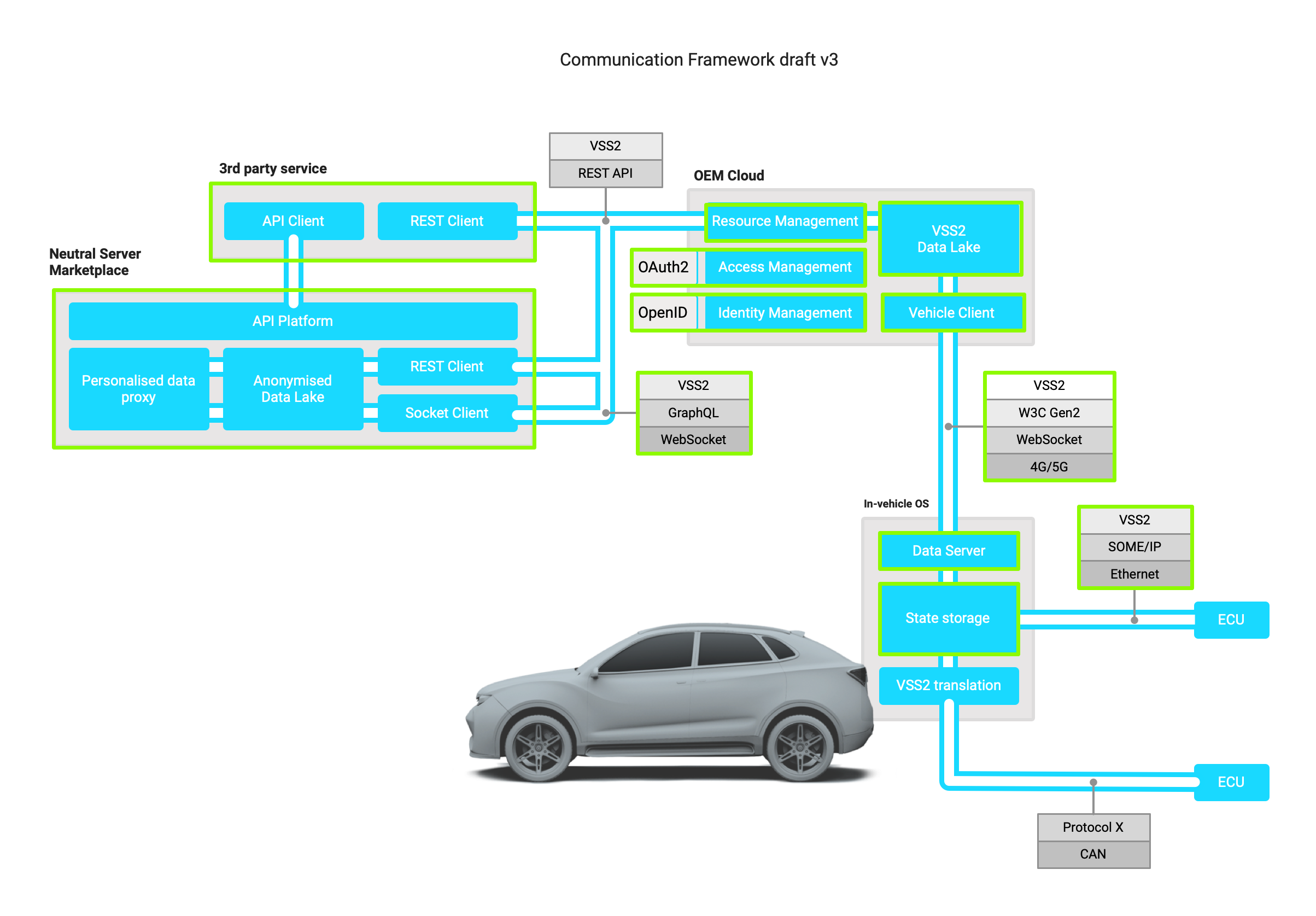You are viewing an old version of this page. View the current version.
Compare with Current
View Page History
« Previous
Version 6
Next »
This page lists the different components and tasks to be completed for the architecture discussed on the Vehicle data exchange protocols page. The table references to the following diagram, with components that are considered in scope for the PoC highlighted with green color.

Apache License is more preferred by participants.
| # | Component | Work |  Software Components / Implementation details (PoC) Software Components / Implementation details (PoC) | (WIP, future)
Software Components / Implementation (Production) | Owner |
|---|
| 1 | In-vehicle
State storage
(laptop simulator) | - Custom code + in-memory database (+ persistence) + connection to feeder
- Either locally cached during uptime of system or
- Stored and indexed in a database to allow access to historical data
- Selection of database
- Implementation of database schema
| - Custom control code (Python or C++)
- + sqlite binding, OK for PoC
| | Gerald investigating (KUKSA) |
| 2 | In-vehicle VSS2 translation (a.k.a. VSS feeder)
(laptop simulator) | - Implementation of SOME/IP client?
- or simple simulator
- or Vehicle Driving Simulator (LG? OpenDS? or GENIVI GitHub version?)
- = set up simulator, make it drive around track, get list of available signals, write code to convert signals to VSS...
- Signals are fed over DDS to AutoWare or Apollo autonomous driving stacks.
- Sim needs a high-end graphics machine
- Look if VSI or VSD should play a part
| - Custom code, feeding simple simulated data
then (future) run full vehicle driving simulator |
| Gerald investigating (KUKSA) |
| 3 | In-vehicle Data server
(laptop simulator) | - Data server implementation for W3C Gen2
- Reference implementation exists in GitHub MEAE-GOT
- Ulf can work together with someone how to connect to an existing API of "state storage"
- (also talk to Kuksa project - VISS+REST server)
| Use server directory from W3C_VehicleSignalInterfaceImpl
|
| Ulf |
| 4 | OEM Cloud Vehicle client | - W3C Gen2 protocol (VISS Websocket Pub/Sub)
- Options:
- Investigate Sanjeev's work for reusable client
- Curl script
- Custom code + HTTP library (e.g. written in python) custom code + libcurl binding
- Client directory from MEAE-GOT/W3C ?
- No clear answer. Depends on use-case. What is the rate of data for example?
- Sanjeev: It would make sense to write also client in Go.
- This program shall also store the data into the data lake program (or directly into the database used as data lake)
| - Sanjeev starts: New client written in Go
Separate repository (GENIVI GitHub)
Integrate with MEAE-GOT server repo makes sense.
git submodule could be an option
|
|
|
| 5 | OEM Cloud VSS2 data lake | - Selection of libraries and database to handle data lake
- Can we get BMW help to define a relational database schema, and maybe also the implementation?
| - Custom control code (Python or C++)
- + Sqlite binding, OK for PoC, or other database such as postgresql.
- Need to define database schema first
|
| Kevin to ask in Geotab |
| 6 | OEM Cloud Identity management | - Implementation of end-user login and authentication using OpenID
- Lots of candidates. Responsible implementer should propose a good alternative.
| Later. programming language preference could be influenced by the programmer
|
|
|
| 7 | OEM Cloud Access management | - Implementation of authorization between end-user and 3rd party application or Neutral Server using OAuth2
| Later. programming language preference could be influenced by the programmer
|
|
|
| 8 | OEM Cloud Resource Management
= Data server API | - Implementation of basic API management
- Resource Mgmt is the ExVe naming.
- Implementation of a GraphQL API using the VSS2 schema
| GraphQL → Apache Apollo? |
|
|
| 9 | Neutral Server Data Marketplace | - Separate instance that consumes the OEM Cloud OAuth2 and GraphQL APIs
- We could implement a very simplistic neutral server using the published API of High Mobility, but an open implementation.
- Security, consent and other complicates things. Leave those details out.
|
|
| Kevin |
| 10 | 3rd Party Application | - Example applications exist on High Mobility's GitHub
- One instance that consumes the Neutral Server/Data Marketplace APIs
- Use an example application from HM
- For example an app that just shows the data (written in Node.js)
- One instance that consumes the OEM Cloud OAuth2 and GraphQL APIs
- Modify the application to use the OEM API directly
|
|
| Kevin |